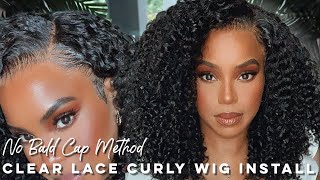Do Lace Front Wigs Damage Your Hair?
- Posted on 02 November, 2021
- Lace Front Wig
- By Emma & Stuart

Lace front wigs are known for their many benefits, making them a popular choice amongst the wig-wearing community. Lace front wigs create the illusion of a natural hairline, giving you the confidence to look and feel great whilst wearing your wig. However, there are many myths regarding lace front wigs and wearing wigs in general.
Here, we uncover some common myths by answering some frequently asked questions surrounding wig damage such as do wigs damage hair? And do lace fronts damage hairlines? To determine once and for all if wigs, especially lace wigs, can damage your hairline.
Do Wigs Damage Hair?
Do wigs damage hair? The answer is no; they don't. This is a very common myth, and the truth is, wearing a wig has many benefits:
ONE
They can help cover areas of hair loss.
TWO
Gives you a whole new style and offers an opportunity for experimentation and creativity.
THREE
Overall they can take you from feeling drab to fab, helping to restore a feeling self-confidence for many.
However, incorrect application and removal of wigs can lead to damaged, dry or brittle hair. Not following the best wig practices, such as not correctly removing your wig or constantly wearing your wig, can irritate your scalp and hair. In the long term, this irritation could cause damage. That's why taking care of your own hair should always be a top priority.
Do Lace Front Wigs Damage Your Hairline?
When it comes to asking whether lace front wigs damage a hairline or not, it's important to consider the method you are using to put on your wig and how you look after your wig and natural hair.
The answer to the question, ‘can lace front wigs damage your hairline alone?' is no. Like the answer to ‘do wigs damage hair?', it's not the wig that damages the hair. However, this depends on the methods used for application, removal and general maintenance. As our natural hairlines are so delicate, with much less flexibility than the hairs on the rest of our head, these hairs are much more susceptible to damage.
Lace Front Wig Damage Prevention
Now that we know that wigs and lace front wigs aren't to blame for any damage to the hairline, the only way to ensure that any lace front damage is avoided is to carry out the correct wearing and securing removing and care practice.
We've collected our expert top tips, covering all these areas to ensure that your hairline remains intact to keep you looking and feeling fabulous.
Create a flat surface with your natural hair
In order to carry out the correct application of your lace front wig, be sure to create a flat surface with your natural hair. If your hair is long, we recommend braiding your hair before applying your wig to create a smooth surface. Therefore, creating a good foundation for your wig application. Before you apply any adhesive, it's important your hair feels secure, which is best to be established at this early stage.
Use a compatible lace front glue
There are specific glues that you can use that are designed to secure lace front wigs; we would always recommend using one of these glues to avoid any damage occurring to your hairline. Use only enough glue to create a tacky texture before fixing your wig to your head. For more information on how to put on your lace front wig and the different methods you can use to secure it, please read or guide.
Top tip: As with any new wig glue you try, be sure to do a patch test on your skin to see whether you are allergic to it or not before using it during application!
Remove with care
Just as you can get specific glue to apply lace fronts, you can also get specific adhesive-remover to help remove lace front wigs too. All you need to do is apply enough adhesive-remover to soften the glue so that you can slowly take the wig off with ease. If you do feel like the wig isn't removing easily, then apply more of the remover, and then wait for a few minutes before you try removing the wig again.
Tips for Reducing the Risk of Damage
As we've mentioned above, it's important to always take care of your scalp and natural hair to reduce the risk of damage. Here are some additional ways to prevent any damage to your hair when wearing a wig:
1. Don't wear the wrong size wig
When it comes to wigs, there isn't a one size fits all. Wigs typically come in three sizes: average, petite and large. If your wig is too small, it can feel incredibly tight and uncomfortable. Wearing the correct wig size will allow you to feel much more confident to wear your wig throughout the day, knowing that you feel comfortable. To find the right wig size for you, please take a read of our sizing guide.
2. Don't wear the wrong wig cap construction type
Your preferred wig cap construction is a personal choice for you. Your choice of wig cap construction won't necessarily be the cause of any damage, but it can help to reduce any irritation. For instance, if you find that your head often gets hot underneath your wig, and you tend to scratch your scalp, this could lead to long term irritation. In this case, a capless wig may be the best choice for you as the open wefts allow your head to breathe.
3. Don't forget to wash your hair
Just as you would wash your lace front wig, taking care of your natural hair is key. It's important that you look after your natural hair and your wig so that they don't become dry and brittle from skipping any washes and conditioning.
To keep your scalp and hair as healthy as possible, it's beneficial to wash your own hair often. Be sure that your hair is fully dry before applying your wig as any moistness under your wig may cause bacteria to grow, causing problems for your hairline.
4. Don't create tension on your scalp
To keep your hair in the best condition whilst wearing wigs, it's important to take care of your natural hair. You may choose to braid your hair underneath your wig. If you do, it's important to make sure that these braids aren't too tight to prevent any unnecessary tension on your scalp. If your braids are tight, they can pull on your natural hairline, making your scalp feel very irritated and therefore can make wearing a wig very uncomfortable.
5. Don't overlook taking care of your hair
Although your wig will cover your natural hair, it's still important to take care of your hair and give it a bit of TLC. For instance, if you do braid your hair underneath your wig, make sure to remove these braids every few days. This allows you time to thoroughly brush and wash your hair to remove any potential dirt, tangles or knots. Once you've taken care of your hair and allowed it to thoroughly dry, you can get ready to apply your wig.
6. Don't skip the wig cap
Wearing a wig cap is a personal choice that is completely down to you. Some people prefer to wear a wig cap whilst others skip the wig cap altogether. We recommend wearing a wig cap to create a protective barrier between hair, hairline and your wig. A wig cap prevents any friction from occurring and allows wearing a wig to feel much more comfortable. Whatsmore, a wig cap also helps create a flat surface beneath your wig, which should help make your wig appear more natural.
7. Don't forget to let your hair breathe
As much as wigs can make us look and feel fabulous, it's important to mix things up from time to time to give your scalp and natural hair a break from tape and adhesives. Remember to take a break from wearing wigs; this will allow your scalp and hair to breathe. That's why we don't recommend wearing your wig when going to sleep.
Remember, when exploring the question do wigs damage hair?, be sure to take away these key points:
ONE
If you use the correct care, products, and methods to apply and remove your wig, you have nothing to worry about.
TWO
Don't be afraid of damaging your hairline when wearing lace front wigs. It won't happen as long as you follow the best practices for applying, taking care of and removing your wig.
THREE
The only way that your natural hair or your wig will become damaged is if you don't look after them correctly. To keep your wig in the best condition, it's important to carefully wash and store your wig to prevent any potential wig damage.
For further advice and guidance, learn more about lace front wigs in our ultimate guide. Or you may find our blog on how to protect your hair under a wig an interesting read. To find the perfect wig, you can always browse our gorgeous collection of synthetic and human hair wigs!




